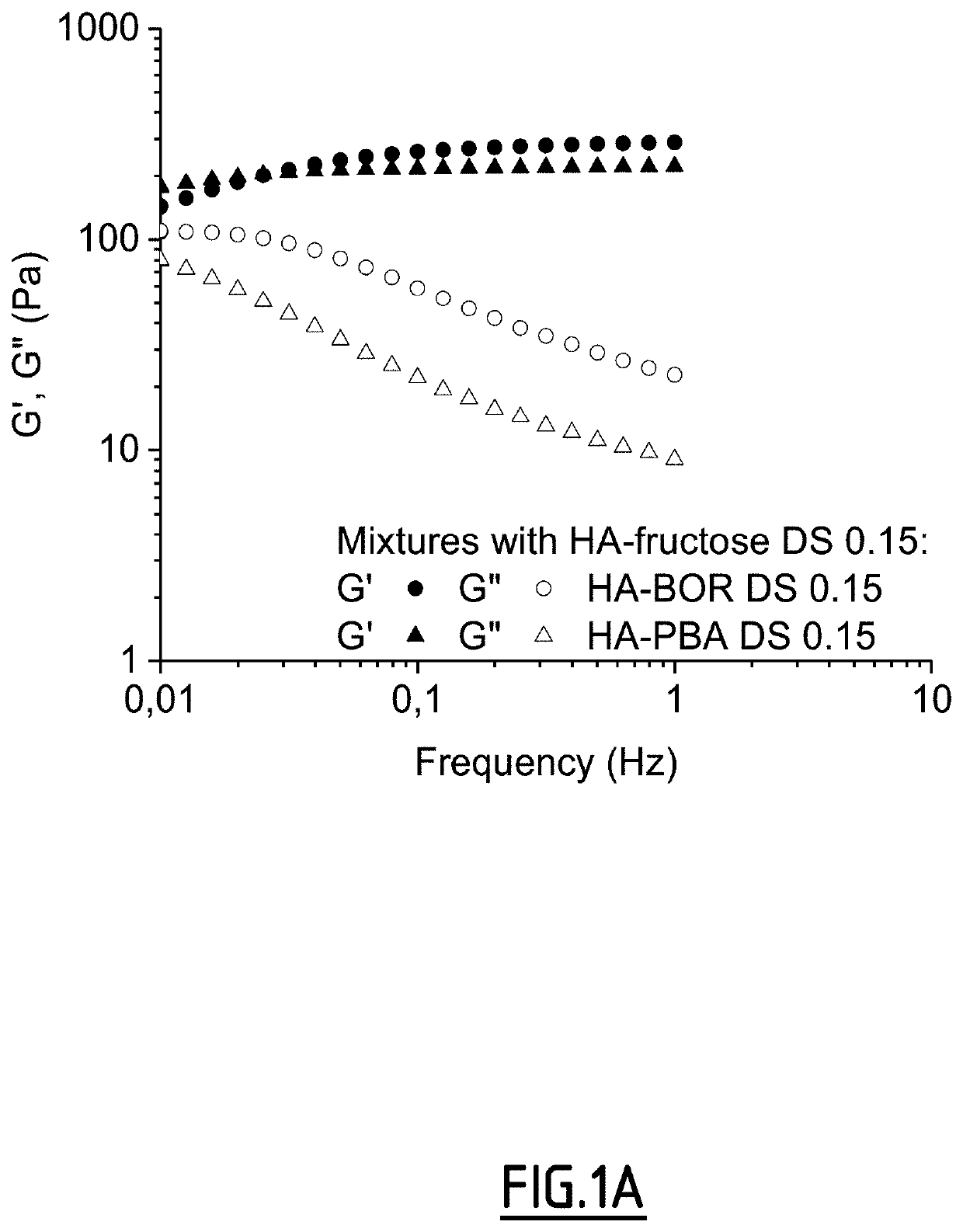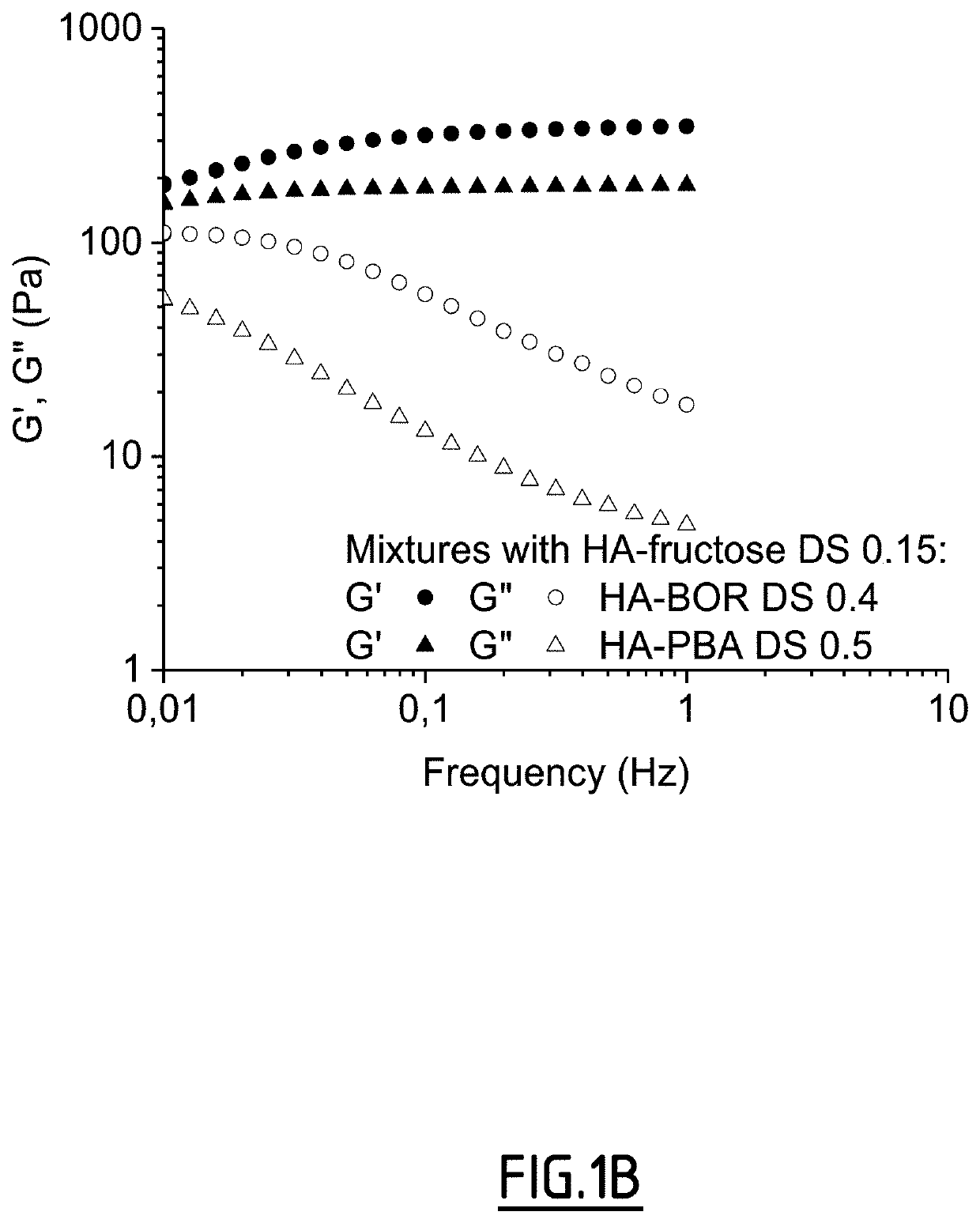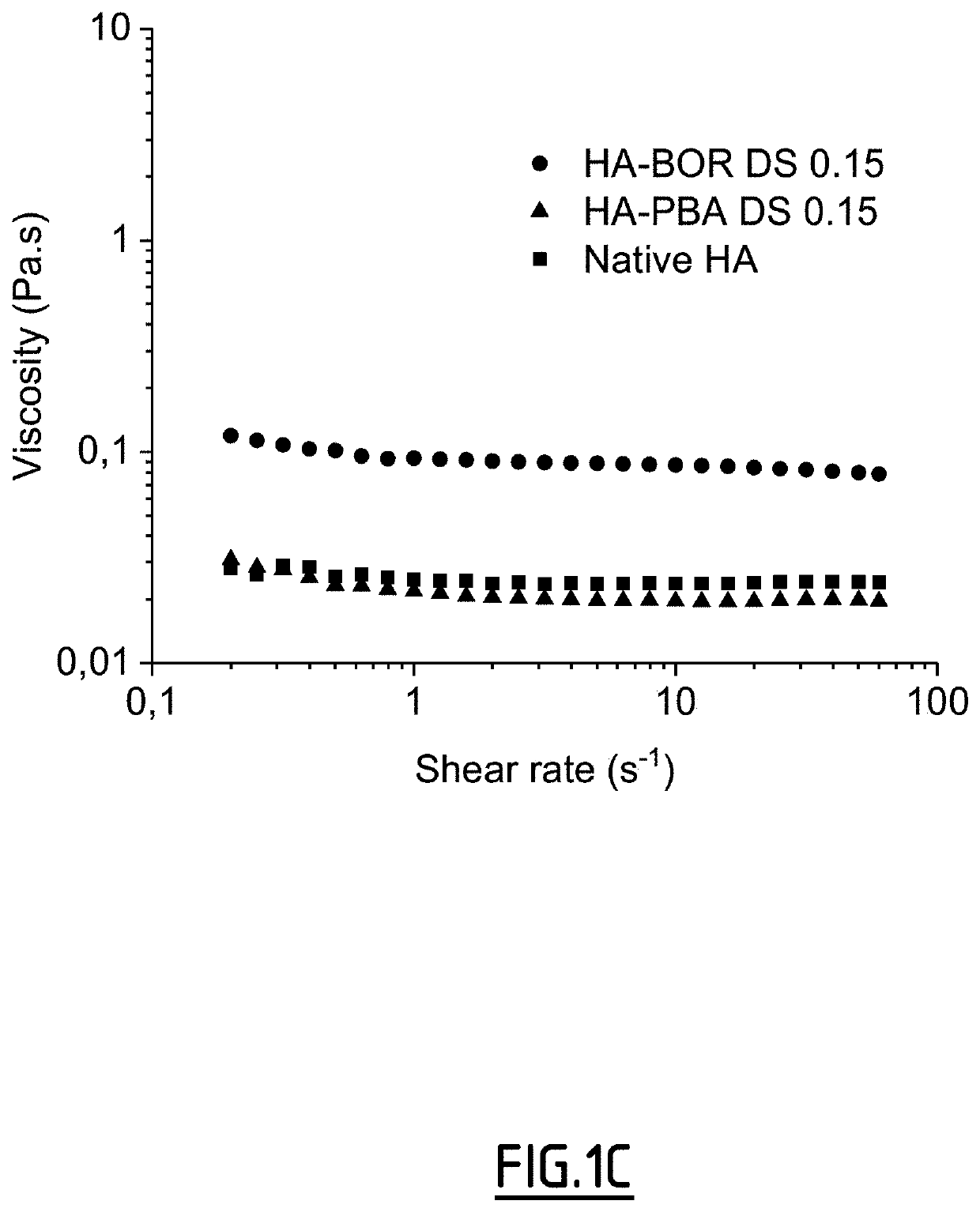Method of crosslinking glycosaminoglycans
Hydrogels with reversible alkoxyboronate ester linkages between glycosaminoglycans address the challenges of high crosslinking density by enhancing injectability and self-healing, offering improved performance in medical and cosmetic applications.
- Summary
- Abstract
- Description
- Claims
- Application Information
AI Technical Summary
Benefits of technology
Problems solved by technology
Method used
Image
Examples
example 1
of HA-BOR
[0183]
[0184]The amine-acid coupling agent 4-(4,6-dimethoxy-1,3,5-triazin-2-yl)-4-methylmorpholinium chloride (DMTMM) was dissolved in 1 mL of water and was added to a solution of native HA in a mixture of water / DMF (3 / 2, v / v). A concentration of HA in the reaction medium of 3 g / L was used for HA samples of 75 and 100 kg / mol, whereas 2 g / L was used for HA with 600 kg / mol. Then, 5-amino-2-hydroxymethylphenylboronic acid hydrochloride (1-hydroxy-3H-2,1-benzoxaborol-amine, ABOR) solubilized in 1 mL of water was added to the reaction medium. The pH was adjusted to 6.5 using 0.5 M HCl or NaOH and the reaction was kept under stirring at room temperature for 24 h. The product was purified by diafiltration with ultrapure water and was recovered by freeze-drying. The degree of substitution (DS) of HA-BOR was determined by 1H NMR (DSNMR), and were also estimated from the reaction kinetics performed using 2,4,6-Trinitrobenzene Sulfonic Acid (DSTNBS). This method consisted in quantifyin...
example 2
of HA-PBA (Comparative Example)
[0186]
[0187]Grafting of phenylboronic acid was done according to Example 1, but using 3-am inophenylboronic acid hem isulfate salt (APBA) instead of 5-amino-2-hydroxymethylphenylboronic acid hydrochloride (ABOR). The degree of substitution (DS) of HA-PBA was determined by 1H NMR (DSNMR), and were also estimated from the reaction kinetics performed using 2,4,6-Trinitrobenzene Sulfonic Acid (DSTNBS). This method consisted in quantifying the free primary amines in the reaction medium as a function of time. Table 1 summarizes the DMTMM / HA and PBA / HA molar ratios used for the syntheses with different Mw HA, as well as the DS and the yields of HA-PBA conjugates.
[0188]HA-PBA: 1H NMR (400 MHz, D2O) δH (ppm) 4.55 (H-1 from N-acetylglucosamine unit), 4.25 (H-1 from glucuronic acid), 3.9-3.1 (H-2, H-3, H-4, H-5, H-6 protons of HA), 2.08 (CH3—CO from HA), 7.93 (s, 1H, NH—C—CH—C—B from Ph), 7.7 (m, 2H, C—CH—CH—CH—C—B from Ph), 7.55 (m, 1H, C—CH—CH—CH—C—B from Ph).
T...
example 3
of Pentenoate-Modified HA
[0189]
[0190]HA (1 g, 2.5 mmol, Mw=100 kg / mol) was dissolved in ultrapure water (50 mL) under continuous stirring overnight at 4° C. DMF (33 mL) was then added dropwise in order to have a water / DMF ratio of (3 / 2, v / v). 4-pentenoic anhydride (0.454 g, 2.5 mmol) was added while maintaining the pH between 8 and 9 by adding 1 M NaOH for at least 4 h. The reaction was kept at 4° C. under stirring for one night. The product was purified by diafiltration with ultrapure water and was recovered by freeze-drying. The degree of substitution (DS) of HA-pentenoate was found to be 0.18±0.01 by 1H NMR. A yield of 49% was calculated considering its DS.
[0191]1H NMR (400 MHz, D2O) δH (ppm) 4.71 (H-1 from N-acetylglucosamine unit), 4.53 (H-1 from glucuronic acid), 4.13-3.2 (H-2, H-3, H-4, H-5, H-6 protons of HA), 2.1 (CH3—CO from HA), 6.0 (m, 1H, CH═CH2), 5.18 (m, 2H, CH═CH2), 2.62 (m, 2H, CH3—C═O), 2.45 (m, 2H, OCCH2—CH2).
PUM
| Property | Measurement | Unit |
|---|---|---|
| mol % | aaaaa | aaaaa |
| degree of substitution | aaaaa | aaaaa |
| yield | aaaaa | aaaaa |
Abstract
Description
Claims
Application Information
 Login to View More
Login to View More - R&D
- Intellectual Property
- Life Sciences
- Materials
- Tech Scout
- Unparalleled Data Quality
- Higher Quality Content
- 60% Fewer Hallucinations
Browse by: Latest US Patents, China's latest patents, Technical Efficacy Thesaurus, Application Domain, Technology Topic, Popular Technical Reports.
© 2025 PatSnap. All rights reserved.Legal|Privacy policy|Modern Slavery Act Transparency Statement|Sitemap|About US| Contact US: help@patsnap.com



